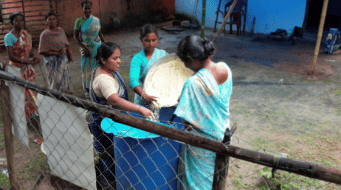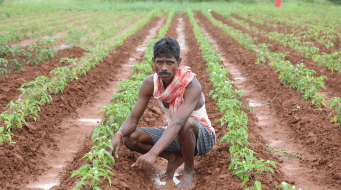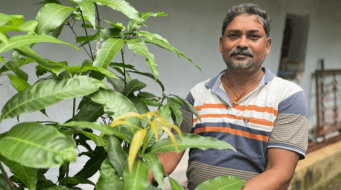By Harshal Khade
Retelling the story of Dunda Dhadwad from Shiswad
I was once asked in the University class of Sociolinguistics by our professor ‘Has your life ever changed by watching a movie?’, I knew the answer at the back of my mind as a resounding ‘Yes’. At that time, I was too hesitant to answer this provoking question in the class (maybe because of the fear that I had to give few instances to support my claim)and remain silent. However, I am quite sure, everyone will have ‘Yes’ for an answer to this question, if we replace ‘movie’ in the question with a story; story in any form viz. text, photos, illustrations, songs etc.
Storytelling as an integral part of our lives
The value of stories in our lives cannot be undermined and the role of storytelling is of the greatest importance while a story takes an audience on a journey. Storytelling is a process which create a world of visualisation in the minds of the audience with the interplay of words, music, visuals, movements. It connects emotions depicted in the story with us or rouses emotions in us and may leave long lasting impressions on our minds. Everyone of us has experienced the joy of good storytelling through different medium and forms. Be it an amazing book, a thrilling cinema, an engaging drama,a graceful dance performance or a creative design, it always makes us realise the power of storytelling.
Storytelling for engaging audience on emotional level
Through storytelling one can connect with others at emotional level. More than words and other elements of story, what reaches us deeper is the emotional connect. Storytelling has this incredible power that creates bond with the audience by the ability to connect emotionally. As long as stories are being created for humans, emotions will have a major role to play in it. Audience can relate to it, they feel connected with a surge of empathy involving in the story.
One can see the difference between a plain narration of an individual and a human interest story in the rest of this blog. In the following paragraphs Dunda Dhadwad from Shiswad village narrates his story of the changes on his farm and how he didn’t need to migrate seasonally anymore. This story was documented as a part of regular reporting on the progress of a lift irrigation project.
The story of Dunda Dhadwad from Shiswad village
“It was a miracle to see my farm getting irrigated in the Summer and the Rabbi season!” says Dhadwad during our visit in March 2017.
Talking about the earlier days, he says “I suffered the same fate as my friends from my village. I would travel to the nearby town of Narayangaon and worked as a daily wage worker. Every day, I would work for 12 hours and get around Rs. 200-300 on a daily basis. I couldn’t afford to commute to and fro! Hence, I would work for a long stretch and then return back home.

6 farmer families came together and contributed towards the cost of installing motor and pipeline! In the month of March 2016, we started getting water through the pipeline! The project became completely functional in the same month and we started getting water through it. In early 2016, I sowed bajra (pearl millet) of indigenous variety. I irrigated my crop thrice with the water received from this lift irrigation project. In rainy season, for paddy crop there was no need to use water drawn from the river.
In rabbi 2016, I grew irrigated wheat and gave water seven times with the interval of 15 days. I harvested 5 quintal of wheat and stored it in grain storage (kothi). After harvesting, I am growing groundnut on my land. I am also growing maize as fodder for animals and green gram too.”
Learning the art of storytelling
In 2019 I had the opportunity to attend a workshop on Storytelling by Shazneen Limjerwala, which helped to understand the basic principles of storytelling. It’s an introductory workshop to storytelling , reiterating the fact that storytelling is an integral part of human culture. Storytelling is a skill that could be developed by applying key principles of storytelling viz. Theming, Setting the context, Characters building and Developing the plot. The more practice we do, the more competent we could become. Personally it will help me become better at storytelling. The basic principles of storytelling that I learnt about were:
- Theming – What is the story about?
- Setting – Building the context of the story
- Character building – Describing the characters in the story’s scheme of things
- Developing the plot – Organising the events in the story
The tale of Dunda Dhawad on applying the principles of storytelling makes for a much more compelling read as can be seen in the narration below:
Dunda’s tale: No migration anymore
I am seeing Dunda Dhadwad of Shiswad village after almost a year in his village. A small farmer practicing rainfed agriculture has now access to water all round year with the lift irrigation project begun last year. His smiling face with his trademark Gandhi Topi (a white coloured sidecap) stayed with me after my first interaction with him. Having a small piece of land measuring to till and hardships aplenty didn’t dent his cheerful demeanour then. This Shiswad village is a small village in Akole block of Ahmednagar district. It is situated in the Sahyadri Mountain range of the Western Ghats in Maharashtra, approximately 120 kms to the North of Mumbai. It witnesses high rainfall in monsoon season. 121 kms away from state capital Mumbai and 587 m from sea level.This village with a population of about 800 faces difficulties in having access to water for irrigation and poor road connectivity where state transport buses ply between the village and nearby town of Rajur twice a day.. The perennial Mula river, originating in Harishchandragad range flows through Shiswad.
He, like many villagers used to travel to nearby town of Narayangaon and worked as a daily wage worker to earn around Rs.200-300. He couldn’t afford to commute to and fro everyday, so he would work for a long period of time and then return back home. “Life was difficult”, Dunda said recalling his life of a wage labourer. “I wouldn’t return home for days and able to come home sometimes only once or twice a month. I had no option but to go for work. My family life was not great. My wife Hirabai has also worked hard all these years. She would even go in villages of Akole and Sangamner to work as an agriculture labourer to earn money for our family.
Even though I had the desire to work in my village and I used to move to townin rabbi and summer season to make a living as a labourer. During the kharif season we used to grow paddy. We didn’t expect much from rabbi season as we didn’t have water available for irrigation. So depending on the soil moisture I used to grow some crops like chickpea and we had no option but to work on daily wages barring kharif season.”
In 2016, when he got to know about the lift irrigation project implemented by WOTR in five villages of Akole block of Ahmednagar district, he along with 5 other farmers in Shiswad village came together and contributed towards the cost of installing motor and pipeline for drawing of water from Mula river. In March 2016, Dunda sowed bajra (pearl millet) of indigenous variety and irrigated his crop thrice with the water received from this lift irrigation project. For paddy crop in rainy season, there was no need to use water drawn from the river.
After harvesting of paddy, in rabbi 2016, he grew wheat for the first time and provided seven rounds of irrigation. He said happily, “I harvested five quintal of wheat and stored it in grain storage (kothi). After harvesting the wheat, I am growing maize as fodder for animals and green gram too in summer of 2017 due to availability of water.”Dunda and Hirabai were quite happy with the fact that they can do farming all year round. Before I leave from Dunda’s home, Hirabai asked me to visit them again and not to forget a copy of their photo, I had just clicked.

What the art of storytelling taught me
The second story is more engaging that the first story. In the second story, the storyteller emphasizes on theming, the development of characters in the story and tries to captivate the audience by narrating a personal account of the story being told. There is a clear setting of the context (in the second story where the audience can successfully visualize the plot with the characters by creating an emotional bond with the protagonist.
Coming back to the question ‘Has your life ever changed by a story?’, I would say‘Yes, it has. Especially when the story is successful in evoking emotions and inspires me to bring about changes in what I think and do.





